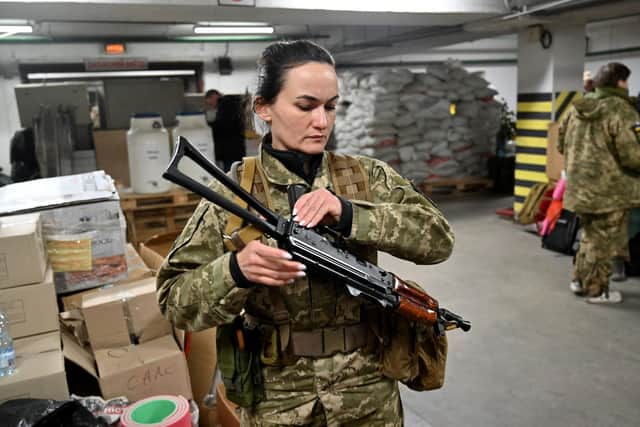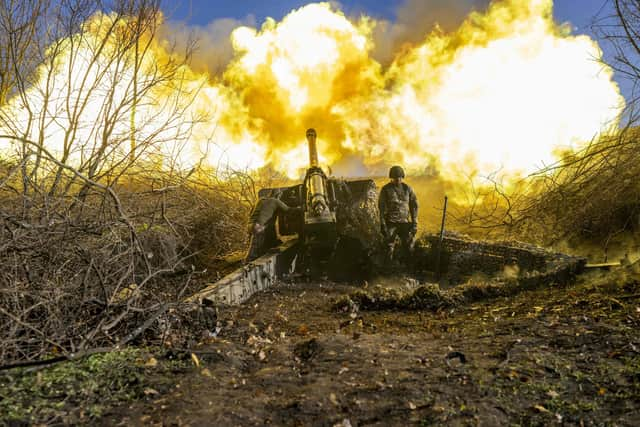Russia's war on Ukraine: Fightback against Vladimir Putin's invasion could see an assault on Russian-occupied Crimea – Stuart Crawford
Much of the story to date is well known, with Putin’s original plan for a speedy, three-days-at-most “special military operation” thwarted by a combination of plucky Ukrainian resistance and Russian military incompetence. Much of the initial Russian territorial gains were then won back by Ukraine’s armed forces via notable victories around Kharkiv, the Donbas, and Kherson before the fronts stabilised into a grinding artillery war of attrition.
As I have said previously, Ukraine will win if it doesn’t lose and Russia will lose if it doesn’t win, and so it has proved. Kyiv has been bolstered by aid from the West which, although sometimes grudgingly bestowed, has allowed the Ukrainians to compete with their much more numerous foe and deny Moscow its aims. And the Russians have proved that they are not the world-class military power that many of us thought them to be.
Advertisement
Hide AdAdvertisement
Hide AdSo, where does it go from here? We have already seen a return to an amount of manoeuvre warfare, afforded by the frozen ground. This may prove to be short-term only. Before too long the ground will soften again as spring approaches and, depending on location, bring with it restrictions on off-road movement.
We recall how the Russians ground to a halt north of Kyiv early on in the invasion, when vehicles which strayed off the relatively few – by western European standards – tarmac roads became bogged in the soft ground and were easy targets for the predatory Ukrainian anti-tank squads equipped with hand-held anti-tank weapons. The same exact same scenario could well be repeated.
We will also see continuing urban warfare. Compared to the Second World War, for example, there are relatively few troops on the ground, too few to man a continuous front line. So we’re likely to witness a continuation of the “war of the settlements”, where towns and villages are fortified and fought over and the intervening spaces are the domain of patrols and minor skirmishes.
We should anticipate that there will be some major offensive moves as the year progresses. The big question is which side will be first out of the traps. Russia appears to be struggling to reform its decimated formations and incorporate its new conscripts and returning reservists to form competent, professional units. The Ukrainians might be quicker if western support holds up.
Here we need to see the West, and particularly the USA, up the ante and provide in numbers what Ukraine’s President Volodymyr Zelensky has been asking for over a considerable period now – modern aircraft and air defence systems, Nato standard tanks and artillery, and long-range precision strike missiles like the US Atacms with its 300-kilometre range. These could really change the balance.


In terms of strategy, I still think the most likely scenario is that Ukraine will seek to mount a major offensive striking south from Zaporizhzhia towards Melitopol and beyond to the shores of the Black Sea, thereby cutting one of Russia’s supply routes to Kherson Oblast and the Crimea. Success here would allow them to move westwards and roll up Russian forces on the left (eastern) bank of the Dnipro River without having to mount a difficult and risky assault across the waterway.
That achieved, Crimea would lie at their mercy, because Russian military bases there come within the range of precision strikes by their Himars and GMRLS missile systems and Russian positions may well become untenable. If, in addition to this, the Ukrainians are once again able to interdict or destroy the now-repaired Kerch Bridge, then the Russians are well and truly on the back foot.
The strategic prize in this war is Crimea, for whoever controls it, and its important naval base at Sevastopol, also controls the Black Sea and the entrance to the Sea of Azov. Putin will not be prepared to give Crimea up as it would signify the total failure of his “special military operation”, so the Ukrainians will have to take it by force. The Americans in particular think this may be beyond them. Well, I’ve heard that before. Let’s wait and see.
Advertisement
Hide AdAdvertisement
Hide AdOf course, the Russians also have a say in what might happen in 2023, and we should not take them lightly or underestimate their capabilities, sullied military reputation or not. Rumours are already circulating that they may be planning a repeat of their assault on Kyiv as soon as they are ready, and Ukrainian planners may have to deal with that first, or at the same time as their own initiatives.


Whatever transpires in the first few months of this year, it looks like fighting will continue for some time yet. I wrote previously that I thought it would all be over by the summer of 2023, but now I’m not so sure. Putin’s most recent speech seemed to underline that the Russians are in it for the long haul, and US Secretary of State Blinken’s statement that China may well be considering sending “lethal aid” to Russian means, if it happens, that the war is likely to be prolonged even further.
Whatever happens, it’s quite clear that Putin’s strategy has failed, and failed badly. In many ways we shouldn’t really be surprised, because his personal background is not military. He’s a spy by trade, and he won’t really understand grand strategy, much as he might like to pretend otherwise. This one has still some way to run.
Stuart Crawford, a former Lieutenant Colonel in the Royal Tank Regiment, is a defence and military commentator
Comments
Want to join the conversation? Please or to comment on this article.